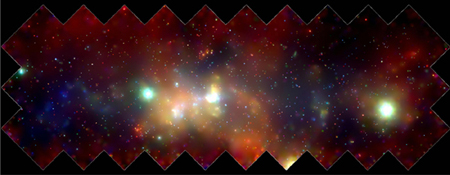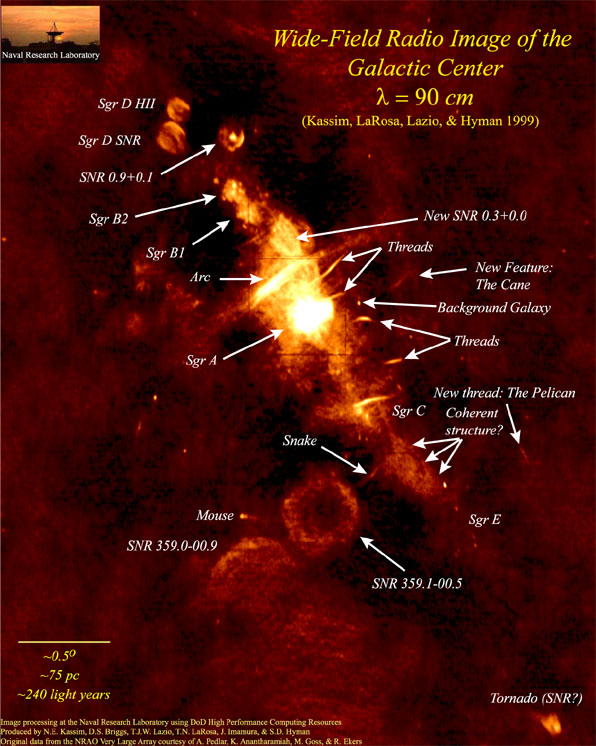6. THE GALACTIC CENTER:
Have yet another look at the Multiwavelength
Milky Way. In the optical band you will see nothing
special at the center of the image, because the light is obscured by dust clouds.
But you will see a bright spot there at radio, infrared, and gamma rays. This
bright spot is called Saggitarius A, because it was first noticed by radio astronomers
as the brightest radio source in the constellation Saggitarius. Now we know
that Saggitarius A is located at the very center of the Milky Way.
Below are X-ray and radio images of the center of the Milky
Way taken at higher angular resolution (with the Chandra and VLA telescopes,
respectively). This movie (source: Chandra)
first pans the X-ray image of the galactic center and then fades from the X-ray
to radio to infrared.
 |
|
X-ray Image of the center of the Milky Way galaxy. Scale is 0.8o
x 2o, or about 400 x 900 light years. Colors represent temperature,
with blue referring to X-ray sources with T > 108 K while
red refers to T < 107 K. Hundreds of blue point sources
are neutron stars, black holes, and white dwarf stars. The diffuse red
glowing areas are hot (> 106 K) gas between the stars. The
bright source at the center of the image is due to X-rays emitted by hot
gas flowing into a black hole at the galactic center. Click on image for
a bigger image. See Chandra
for further details.
|
|
|
| Low Frequency radio image of the center of the Milky Way Galaxy (source),
showing several supernova remnants and a bright radio source
at the center of the Milky Way (called Sagittarius A).
This image is tilted clockwise by about 60o compared
to the X-ray image above. The scale is approximately the same.
|
We know that Sagittarius A is also producing anti-matter. Also
notice the arc to the upper left of Sagittarius A: something wild is going on
there! What? Be sure to check Antimatter
in center of Milky Way. Based on these observations,
astronomers suspected that there was some sort of monster at the center of the
Milky Way -- perhaps a supermassive black hole. The gravity of such an object
might account for the dense cluster of tens of thousands of stars there (which
you can see as the bright spot in this infrared image: The
galactic center across the infrared).
Recently, astronomers found compelling evidence for the black
hole hypothesis. Using very precise infrared imaging techniques, they were able
to see the images of stars moving around the center of the galaxy, as illustrated
below.
|

|
|
Infrared image showing the motions of red giant stars near the galactic
center (indicated by the yellow + sign). The date is shown in the upper
left. From Galactic
center by the Max-Planck-Institute for Astrophysik.
|
The stars are moving as if they are orbiting a compact object
weighing 2.6 million Solar Masses! We know of no other force than gravity that
can account for the motions of these stars, and a black hole is the only object
we know that can be so massive and yet so compact. But even this amazing object
is rather puny when compared to the supermassive black holes that we can see
in other galaxies, as you will see later in this course.
(Return
to course home page)
Last modified March 9, 2002
Copyright by Richard McCray


